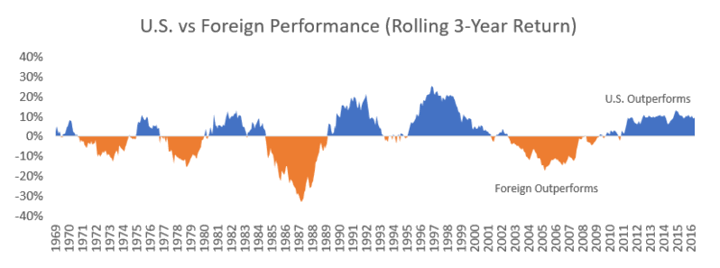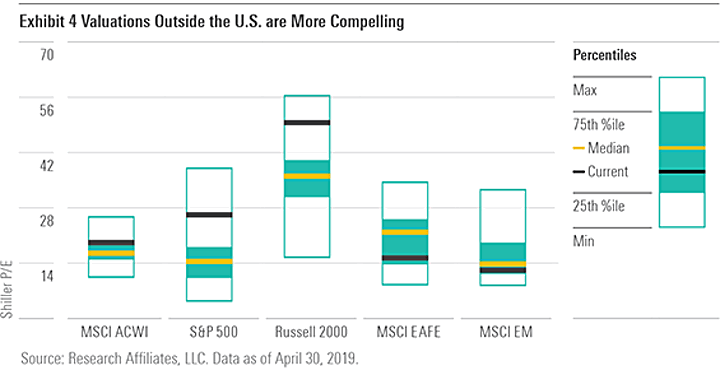One the big decisions in portfolio construction is how much to allocate between US stocks and non-US stocks. You won’t find universal agreement on a correct answer, but this Morningstar article by Ben Johnson does a nice job of outlining the factors behind “home bias”:
“Home bias” is the term used to describe investors’ tendency to tilt their portfolios in favor of domestic stocks (bonds, too, but I’m going to focus on stocks). Here, I’ll discuss how home bias is measured, the factors that underpin this phenomenon, and why it’s probably a good idea to expand your horizons a bit.
Sometimes the US outperforms international stocks for a while. Sometimes it lags. Here is a chart from that helps you visualize these past cycles:

Right now, the market cap of the world’s publicly-traded businesses split at roughly 55% US and 45% international. This ratio has been flipped in the past (45% US/55% International) but the US has performed much better in the past decade.
Right now, the US looks great but International stocks have much higher earnings yields. The most interesting chart from the Morningstar article shows the current Shiller P/E Ratio amid the range of historical valuations for major indexes including the S&P 500, MSCI EAFA (Developed International), and MSCI EM (Emerging Markets). You can see that US stocks are currently on the high (expensive) side, while the international stocks are on the low (cheap) side.

It’s a tug of war. US stocks have done better recently. US stocks have a rosier outlook, which results in them being more expensive. International stocks have a bleaker outlook, but the price-to-earning ratios are much cheaper. If you own a Vanguard Target Retirement 20XX Fund or a LifeCycle Fund, you own 60% US/40% International. Most of the other Target Date Funds break it down differently, so you’ll have to check. I am in the market-weight camp and hold either 50/50 for simplicity. I have seen opinions of what is “best” change over time, and that supports the advice of having a written investment policy statement of what you believe and why.
“The editorial content here is not provided by any of the companies mentioned, and has not been reviewed, approved or otherwise endorsed by any of these entities. Opinions expressed here are the author’s alone. This email may contain links through which we are compensated when you click on or are approved for offers.”
from .
Copyright © 2018 MyMoneyBlog.com. All Rights Reserved. Do not re-syndicate without permission.